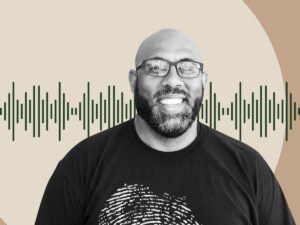
Crises are the fulcrums of who we are as a society. The current COVID-19 pandemic is no exception. From the frontline health care and emergency workers to those building toilet paper igloos in their homes, this crisis spotlights how our past experiences and decisions, our institutions and infrastructure, shape our current behaviors and reactions. And racism is our country’s most powerful shaper.
In just the fifth week of wall-to-wall coronavirus news coverage, we began seeing data on the dramatic consequences of racial inequity. In Chicago, more than 70 percent of virus-related fatalities were among Black people—a percentage more than double their share of the population. In Michigan, African Americans make up about 15 percent of the state population but represented 52 percent of COVID-19 deaths. The same story is playing out in East Coast cities and Southern states where the virus has emerged.
We are told that viruses don’t discriminate, that this is an equal opportunity threat. Epidemiologically that may be true, but the die cast for the virus’ existential consequences has been years in the making.
Repeating history
Government programs and our finance industry are certainly not immune. On March 27th, Congress approved an unprecedented amount of money aimed at softening the pandemic’s economic consequences under the CARES Act. Included in the Act was $359 billion for the Paycheck Protection Program (PPP) to protect small businesses and nonprofits from being wiped out by providing forgivable loans through the US Small Business Administration (SBA).
It was a major victory that for the first time in its history, the SBA opened up its programs to nonprofit corporations. However, the SBA is pushing out those loans through our current banking infrastructure, which has historically failed communities of color.
Millions of small businesses and nonprofits, particularly those owned or led by people of color, applied to their local banks and heard, as many of us predicted, less than desirable responses:
- “Our bank is not participating.” (Many small and rural community banks do not have the liquidity to quickly implement a new program with few articulated rules and timelines.)
- “We are only serving our current customers.”
- “We are only serving current customers with current loans.”
- “We are only taking applications for (or prioritizing) larger loan amounts.”
- “We are only taking complete applications and can provide no technical assistance.”
NPQ documented many of these rejections in its April 10, 2020 article.
I say “predictable” because businesses owned by people of color have historically had difficulties obtaining capital from traditional banking systems for myriad reasons similar to those above: too small, not enough collateral, not enough wealth, no co-signers with wealth, not “sophisticated” enough, etc.
Those able to defy the odds and stay alive despite these systemic barriers often did so at the fringes and while operating on slim margins. Now, faced with the pandemic’s titanic challenge, they are asking the government for the assistance they were promised. And being denied again.
Once again, the fulcrum of crisis sharpens our ability to see the consequences and self–perpetuation of systemic racism.
These businesses will not be turned down because of race—that’s illegal. They will be turned down because they don’t have existing relationships, which they don’t have because of the persistent racial wealth and income gaps resulting from decades of racial inequalities.
And the result will be that these established, Black-owned businesses will be destroyed.
Fast forward to five years from now. New Black-owned businesses will emerge, and they will apply for loans. Banks will turn them down, saying those new businesses are too new, too small, and don’t have enough wealth. Will we remember that the more established businesses were wiped out in the last (this current) crisis?
Viewed through this lens, we can identify the Four Horses of the Equity Apocalypse: Lack of Time, Lack of Resources, Lack of Relationships, and Lack of Diversity.
We must interrupt this cycle, here and now, to prevent these historical gaps from being exacerbated and permanently ensconced in our industry. We must, now more than ever, be focused on equity.
Interrupting history
Community Development Financial Institutions (CDFIs), unlike most banks, have strong relationships with, and understandings of, small businesses and nonprofits that serve lower-income communities. We understood from the beginning how the first round of the PPP program would quickly play out as history repeated itself.
The second round of stimulus funding, approved April 24th, injected another $320 billion into the PPP—and we’re glad to see that $30 billion of that is reserved for “community financial institutions,” including CDFIs authorized to make PPP loans.
But this small legislative victory is not enough to change the course of history. We must also look at ourselves as an industry.
Every CDFI that I know is working around the clock to protect themselves, prepare for the coming economic onslaught, and figure out how to protect and help their customers. There has been little time for anything else. And there stands the first of those Four Horses of the Equity Apocalypse: “Lack of Time.” It is followed quickly by its comrades: Lack of Resources, Lack of Relationships, and Lack of Diversity.
If we are going to interrupt these cycles of systemic inequity, each of our organizations has to face these problems head on. I say “face” because none of them are going to disappear, certainly not anytime soon. But by calling them out and confronting them, we can better understand and mitigate their effect on our actions and their results.
Sign up for our free newsletters
Subscribe to NPQ's newsletters to have our top stories delivered directly to your inbox.
By signing up, you agree to our privacy policy and terms of use, and to receive messages from NPQ and our partners.
Emergencies are the ultimate time crunch, and we will all succumb to making fast decisions. But now is the time to interrupt. Now is the time for us to pause, and think, and take time to ask ourselves and our staffs:
- Who benefits from the activities we are focused on right now?
- Who doesn’t benefit?
- Who might be harmed by these activities?
- If we are only focused on current clients, what potential future clients might be wiped out or significantly hurt?
- Are those potential future clients more likely to be applicants of color?
In the more equitable world that we aspire to, we have a duty to both our current clients and our potential future clients.
My organization, IFF, is a long-term lender to nonprofits for facilities and equipment. Normally, we would not think about participating in a “working capital” loan program like PPP. Normally, we focus on nonprofits ready for real estate ownership.
But these are not normal times, and so we made some departures from our normal decision-making.
By asking ourselves who would be harmed by staying away from PPP, we realized that the very places we serve—smaller nonprofits, many of which are led by people of color—would be most hurt because they would have the most difficulty with the traditional banking system. We decided we had to promote the Paycheck Protection Program in some way.
Then, as we focused on our existing clients, we realized that, while they represented the smallest of agencies that could own their own facilities, they did not represent newer and smaller organizations that were not yet at the ownership stage—agencies that would be hurt, and possibly eliminated, in the current climate. And, so, we realized that we had to go beyond our current client list.
Scarcity of resources dominates the nonprofit world. But we have to interrupt scarcity thinking. Ask yourself: how can you divide your available resources in a more equitable way? How could you find additional resources if you focused on equity as a goal for their distribution?
Every nonprofit, like every CDFI, will have a different formula for interruption based on their size and resources. One easy way of interrupting is always applying the 10 or 20 percent rule. We generally always think about how we can increase something by 10 or 20 percent. So just do that, except always focus any marginal increase solely on clients of color. Consider:
- Commit that for every 10 clients you help, you will intentionally help three or four or five new clients of color.
- If most of your existing clients are already people of color, then commit to making sure that, for every 10 you already know, you find one or two or three more entirely new clients that might be more challenged in finding resources.
Whatever your usual formula, interrupt it. Expand it. Focus it on the goal of equity and inclusion.
If you’ve faced the first two horses (Time and Resources), you will invariably see the third rear its limiting head: Lack of Relationships. In a white-dominated world, many types of relationships tend to be dominated by those who are white, with connections who are predominately white. So, when we decide and find the resources to increase our number of clients, we can quickly realize we do not have the breadth of relationships to connect more deeply to populations of color.
In IFF’s case, because of our traditional focus on agencies ready to own facilities—which tend to be larger and better resourced—we have too often been isolated from smaller and deeply under-resourced nonprofits working in communities of color. We needed to break out of our “mailing list.” So, we turned to multiple local foundations, United Ways, and government partners, and asked them to share our ability to assist small nonprofit agencies obtain PPP loans. (And we fully understand that we need to work deeply on our mailing list post-pandemic too.)
As IFF made difficult decisions and began working with different loan products for a different client base—thus raising our collective anxiety—we were also very aware that we cannot just think about the lending side of this. We also have to make sure that all of these small agencies can comply with the rules so that they can get their loans forgiven. Otherwise, we may be harming them.
And now on to the final horse of the equity apocalypse: Lack of Diversity.
Like many nonprofit organizations in recent years, IFF has worked hard at diversifying its staff and board. We have made significant progress towards this goal, but we also know we have a long way to go. The benefits of diversity in thought and experience—to decision making, and to our collective soul—are self-evident, I hope. But I do also want to note that diversity alone is never enough: equity and inclusion are also essential, and harder to achieve. These elements must be considered in tandem, in collaboration with all parts of an organization, and with substantial financial and organizational support.
When time is crunched and resources are threatened, organizations tend to fall into old patterns of decision-making. They tighten decision-making circles (not inclusive) and put blinders on to questions of who is harmed and who benefits (not equitable). We need to constantly evaluate our commitment to including and being accountable to diverse voices on our teams. Doing so helps ensure we are not only responding quickly but responding equitably. The people who we invite into conversations—not just for their presence, but for their insights—represents a Trust Contract with both staff and clients. We are asking them to trust us to hear their voices, represent their concerns, and respect their perspectives.
…
In the first round of PPP funding, IFF started late. But we boldly declared that we would be the backstop for Midwestern nonprofits shut out of traditional finance, and therefore shut out of the PPP in particular.
We formed a partnership with Community Reinvestment Fund, an SBA-approved lender, to make the loans that we are pulling in from smaller nonprofit agencies we’re coaching through the paperwork process. Together, our two CDFIs committed to deploying $50 million in loans to Midwest nonprofits.
We reached out through our foundation and government channels to go beyond our usual customer base, and we received nearly 200 inquiries in two days. (IFF normally approves about 120 loans in a full year.) We then partnered with and referred agencies to Financial Management Associates (FMA), which provides counseling to nonprofits about the PPP loans and how to comply with the rules to make sure they are forgiven.
And then the government ran out of funds. We kept taking applications in anticipation of the newly approved funding, and we haven’t stopped finding new partners to share our willingness to help any qualifying agency, regardless of how small. This Monday, when the second round officially opened, we filed nearly 60 loans for nearly $7 million, and we continue to take applications. (So far, the average PPP loan IFF has helped process is less than $100,000, and the smallest is $1,500.)
Honestly, we are nervous about liquidity and staff resources to make this move, but our senior management team unanimously agreed that we will not return to the status quo. We must continue to interrupt it.













